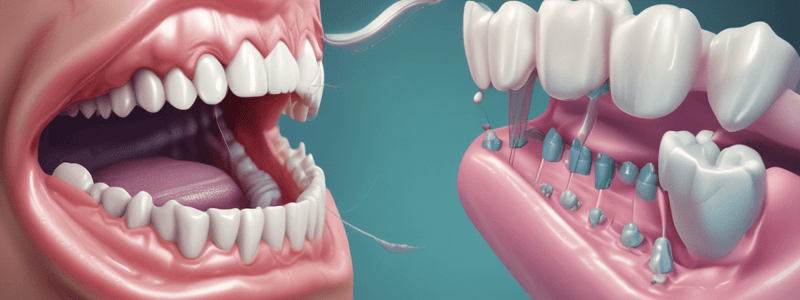Podcast
Questions and Answers
What is the primary cause of periapical periodontitis?
What is the primary cause of periapical periodontitis?
- High filling or biting on a hard object
- Abscess formation
- Widening of the periodontal ligament space
- Death of the pulp due to pulpitis (correct)
What is a common symptom of acute periapical periodontitis?
What is a common symptom of acute periapical periodontitis?
- Intense throbbing pain (correct)
- Facial asymmetry
- Gingival bleeding
- Tooth hypersensitivity to heat
Radiographically, what is a characteristic of acute periapical periodontitis?
Radiographically, what is a characteristic of acute periapical periodontitis?
- Root canal calcification
- Bone resorption
- Widening of the periodontal ligament space (correct)
- Loss of lamina dura
What is the pathology of acute periapical periodontitis?
What is the pathology of acute periapical periodontitis?
When is a tooth responsive to vitality tests in a patient with acute periapical periodontitis?
When is a tooth responsive to vitality tests in a patient with acute periapical periodontitis?
What is a rare complication of acute periapical periodontitis?
What is a rare complication of acute periapical periodontitis?
What is the radiographic appearance of the border of focal sclerosing osteitis?
What is the radiographic appearance of the border of focal sclerosing osteitis?
What is the most common outcome of treating focal sclerosing osteitis with RCT or tooth extraction?
What is the most common outcome of treating focal sclerosing osteitis with RCT or tooth extraction?
What is the key radiographic feature of periapical granulomas?
What is the key radiographic feature of periapical granulomas?
What is the histological appearance of periapical granulomas?
What is the histological appearance of periapical granulomas?
What is a characteristic of granulation tissue in periapical granulomas?
What is a characteristic of granulation tissue in periapical granulomas?
What is the process by which a periapical granuloma can lead to a radicular cyst?
What is the process by which a periapical granuloma can lead to a radicular cyst?
What is the primary goal of endodontic treatment in managing acute periapical periodontitis?
What is the primary goal of endodontic treatment in managing acute periapical periodontitis?
What is the common sequela of chronic periapical periodontitis?
What is the common sequela of chronic periapical periodontitis?
What is the characteristic radiographic feature of chronic periapical periodontitis?
What is the characteristic radiographic feature of chronic periapical periodontitis?
What is the primary difference between acute and chronic periapical periodontitis?
What is the primary difference between acute and chronic periapical periodontitis?
What is the purpose of open drainage through skin or mouth in managing acute periapical periodontitis?
What is the purpose of open drainage through skin or mouth in managing acute periapical periodontitis?
What is the characteristic feature of a periapical granuloma?
What is the characteristic feature of a periapical granuloma?
What is the difference between a periapical granuloma and a radicular cyst?
What is the difference between a periapical granuloma and a radicular cyst?
What is the purpose of radicular cyst enucleation in treating chronic periapical periodontitis?
What is the purpose of radicular cyst enucleation in treating chronic periapical periodontitis?
What is the characteristic feature of focal sclerosing osteitis?
What is the characteristic feature of focal sclerosing osteitis?
What is the primary cause of periapical granuloma development?
What is the primary cause of periapical granuloma development?
What is the outcome of acute inflammation when there is substantial tissue destruction and in non-regenerating tissues?
What is the outcome of acute inflammation when there is substantial tissue destruction and in non-regenerating tissues?
What type of cells are involved in chronic inflammation?
What type of cells are involved in chronic inflammation?
What is the primary cause of pulpitis?
What is the primary cause of pulpitis?
What is the outcome of pulpitis?
What is the outcome of pulpitis?
What is the cause of an increase in pulpal pressure?
What is the cause of an increase in pulpal pressure?
What is the pulp chamber enclosed in?
What is the pulp chamber enclosed in?
What is a factor that influences the healing of the pulp?
What is a factor that influences the healing of the pulp?
Which type of cells is not typically found in acute inflammation in the pulp?
Which type of cells is not typically found in acute inflammation in the pulp?
What is a characteristic of reversible pulpitis?
What is a characteristic of reversible pulpitis?
What is the treatment for irreversible pulpitis?
What is the treatment for irreversible pulpitis?
What is a feature of chronic hyperplastic pulpitis?
What is a feature of chronic hyperplastic pulpitis?
What is the difference between open and closed pulpitis?
What is the difference between open and closed pulpitis?
What is a characteristic of the granulation tissue in pulpal polyp?
What is a characteristic of the granulation tissue in pulpal polyp?
What is the primary difference between reversible and irreversible pulpitis?
What is the primary difference between reversible and irreversible pulpitis?
What is a symptom of pulpitis?
What is a symptom of pulpitis?
What is the difference between local and systemic factors influencing the healing of the pulp?
What is the difference between local and systemic factors influencing the healing of the pulp?
Flashcards are hidden until you start studying




